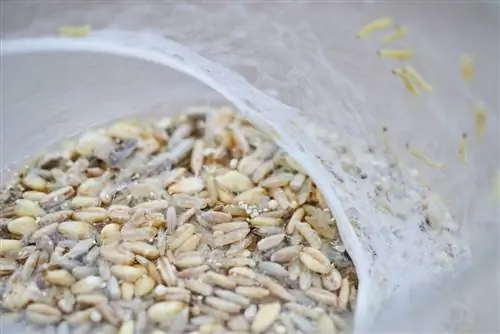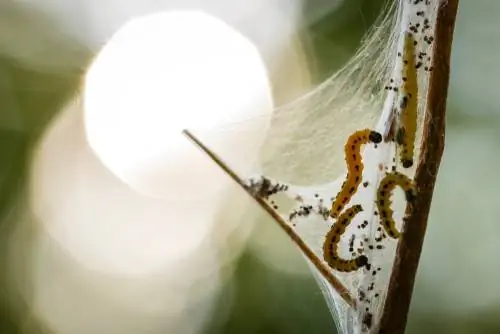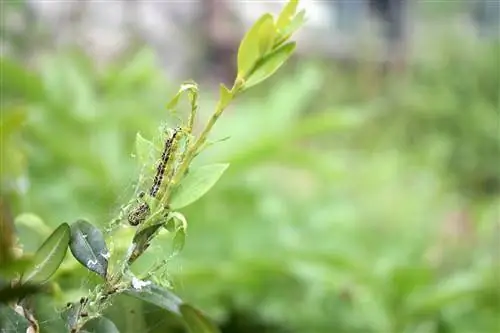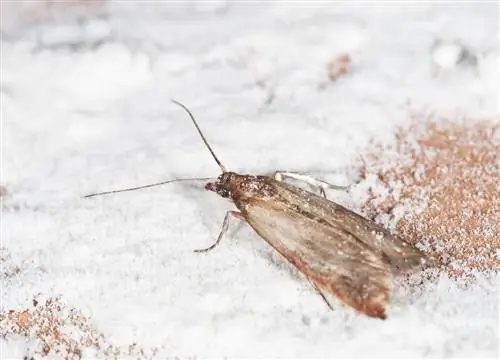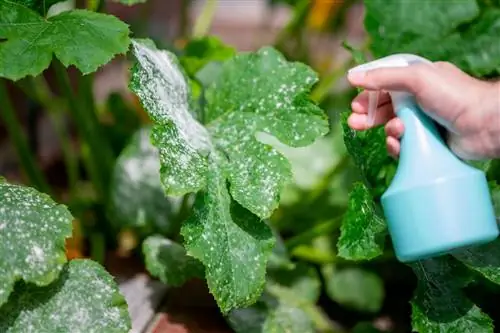- Author admin [email protected].
- Public 2023-12-16 16:46.
- Last modified 2025-06-01 06:02.
Flour moths spread fear and terror in the kitchen. When flour, muesli or oatmeal comes to life and small moths crawl in the pantry, those affected rightly ask themselves: What to do about meal moths? This guide explains poison-free control methods with tried-and-tested instructions. You can find out here where the nasty storage pests come from, how you can recognize the beasts and destroy them without chemicals.

- Flour moths are widespread pests of stored goods and belong to the butterfly group of borers (Pyralidae).
- The voracious caterpillars are harmful and destroy food over a period of up to 60 days.
- A wide range of non-toxic agents and procedures are available to combat meal moth maggots.
Fighting flour moths - what helps?
Flour moths are feared pantry pests. The butterflies and their maggots contaminate dry food with their waste. Feces and thread-like webs provide ideal living conditions for mites, fungi and bacteria. This fact makes meal moths a harmful pest. Using chemical insecticides is frowned upon in the immediate living environment. Victims of flour moth infestation are not a lost cause. The following table provides a summary overview of the poison-free control of maggots, eggs and butterflies:
| Immediate measures | Home remedies | poison-free control | Control/Decimation | Prevention |
|---|---|---|---|---|
| vacuum cupboards/containers | Freezing | Parasitic wasps | Pheromone Trap | Essential oils |
| Cleaning with hot water | Heating | Diatomaceous earth | Glue trap | fly screen |
| Wipe with vinegar | Soda | Throw away contaminated items | Airtight storage | |
| Heating niches with a hairdryer | Lavender, laurel |
This table lists proven control strategies for getting rid of meal moths and maggots without using toxic chemicals. Have any of the recommended methods piqued your interest? Then read on. Detailed explanations and instructions with practical tips and tricks follow.
Tip
Flour moths leave webs and cocoons in many places in the house. Each cocoon can contain a nest with several hundred eggs. Regularly check the pantry and shelves on the wall to quickly destroy any tell-tale webs with a vacuum cleaner or hairdryer.
Where do flour moths come from?
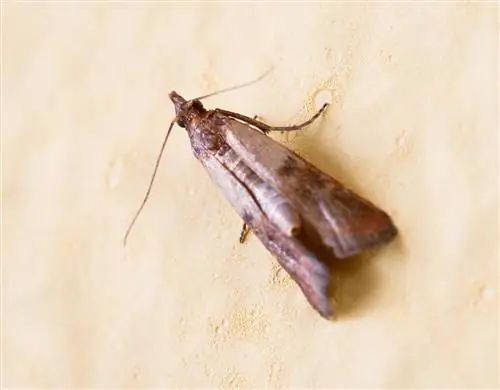
Flour moths enter the house from outside
Sustainable control of mealy moths is crowned with maximum success if you are familiar with the origin and life cycle of the pests. We therefore invite you to take a short foray into the habits of meal moths, which cause us humans so much discomfort.
Flour moths are small butterflies from the borer family. It is not the small butterflies that cause damage in the kitchen, but rather their offspring in the form of maggots. The females lay 50 to 500 eggs, preferably in flour or cereal, but also in tea and other dry foods. Within a few days, each egg hatches into a larva that goes through a total of six caterpillar stages. This process takes up to three months. During this time, the worms eat their way through the food, leaving a trail of feces and sticky threads behind them.
Meal moths get into your food supplies in two ways. The butterflies use tilted windows and open doors as entrance gates. The pests are more often introduced via packaged food. Plastic, cardboard or paper are no obstacle for the pests. With their powerful mouthparts, the voracious maggots simply bite through the packaging material into the land of flour moths.
Excursus
Identifying flour moths and maggots
Locations in the kitchen and in food provide the first indications of a meal moth infestation. The external appearance dispels any remaining doubts about the true identity of the perpetrators. The butterflies and maggots are characterized by the following identifying features: The butterflies are lead gray in color and have a wingspan of 20-25 mm with a body length of 10-14 mm. The significantly lighter hind wings with a whitish, fringed edge are striking. Maggots are whitish with a brown head. A hatched larva is almost 1 mm long. By the time it pupates, the caterpillar reaches a length of up to 20 mm.
Getting rid of flour moths - immediate measures

Flour moth infestation is associated with a high disgust factor and creates an urgent desire to destroy the pests as quickly as possible. In the early stages you can take immediate measures to get rid of nasty moths, eggs and maggots. Gradual cleaning in the following steps has proven to be successful:
- Clean cupboards and drawers thoroughly with the vacuum cleaner
- Clean the locations with hot water
- Soak the cloth with vinegar and a little peppermint oil and wipe again
- Heat niches, gaps, cracks and areas with a hairdryer
- Suck and wipe again (dispose of vacuum cleaner filter immediately)
Please dispose of contaminated food in the trash can. As an exception, packaging does not go into the yellow bag, but also goes into the household waste. Storage containers should be meticulously cleaned in the dishwasher or in hot detergent water. The pheromone trap is a non-toxic control instrument for the success of your immediate measures. Set at least one trap in the kitchen. This guide explains how glue traps work and how they should be handled professionally in a separate section.
Home remedies for flour moth infestation
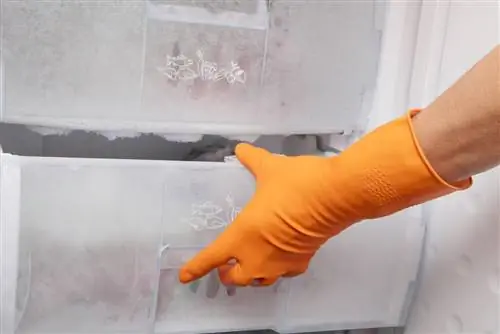
Possibly infected foods that still look edible can be “demotted” in the freezer
Flour moths are tough. With conventional home remedies for pest infestations, no significant success can be achieved in combating them. At best, essential oils, lavender or cedar wood are useful as effective prevention. Thermal methods are a good choice to combat an acute infestation with voracious maggots and cunning moths. What has proven to be excellent in the fight against woodworm can also destroy meal moths. This is how it works:
- Freeze contaminated food and containers for 2 days
- Alternatively: heat infected supplies and containers (if suitable)
- Put in the oven for 90-120 minutes at 60°-80° top and bottom heat
Freezing and heating reliably kills eggs, maggots and butterflies. The food is no longer suitable for consumption. Nevertheless, thermal treatment before disposal is advisable as a biological procedure to prevent spread or re-infestation.
If reusable storage containers, drawers or cupboards are too large for the freezer or oven, subject the infested items to thermal control outside. Under the protection of a foil cover, winter frost or summer heat destroys the pests down to the last niche within one or two days.
Make your own flour moth trap - This is how it works
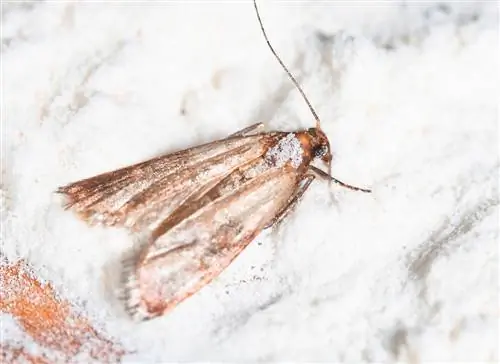
You can eliminate flour moths with flour and baking powder
The preference for flour becomes the downfall of flour moths when baking soda comes into play. Baking soda is not only an important component of baking powder, but also has other useful properties. This includes the fact that sodium hydrogen carbonate changes the pH value in a larva's organism so that it dies. This circumstance increases the effectiveness of a flour moth trap, which you can easily build yourself. This is how it works:
- In a bowl, mix 4 parts baking soda (baking powder) with 1 part flour
- Pull the transparent film over the bowl
- Prick the foil in several places with a thin sewing needle
- Set up a trap in the kitchen, pantry or near food
Female flour moths smell flour as a preferred place to lay eggs. The nocturnal butterflies squeeze through the holes and place the nest in the middle of the flour and baking soda mixture. When the caterpillars hatch, they not only eat flour, but also ingest baking powder and die. The moths can no longer find a way out of the trap, so they cannot create another nest in the kitchen.
Fighting parasitic wasps - This is how it works
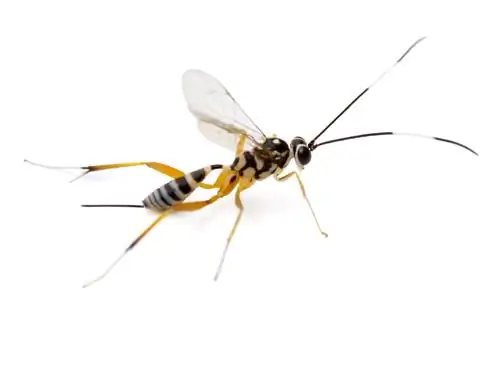
Parasitic wasps are very efficient in the fight against flour moths
Parasitic wasps parasitize flour moth eggs and nip the disgusting pest in the bud. The parasitic species Trichogramma evanescens specializes in food moth eggs as a host for its own offspring. Parasitic wasps find ideal conditions in living spaces, so that parasitism rates of up to 90 percent can be achieved. This fact makes the 0.4 mm small, extremely delicate insects the most successful enemies of meal moths. Once all food moths have been destroyed, parasitic wasps either migrate or die. As a result, there is no need to worry that you will have to deal with a parasitic wasp infestation in the future.
You can buy the powerful shooting aid in combating meal moths from specialist retailers. You will receive cards each with up to 3,000 parasitic wasp pupae in different stages of development. The cards are delivered in 3 partial deliveries. This step-by-step approach over 9 to 10 weeks promises optimal control success. This is how it works:
- Order parasitic wasps, for example 3 x 4 or 3 x 8 cards from Schneckenprofi or another specialist retailer
- First partial delivery with 4 or 8 cards and 3000 parasitic wasp pupae each arrives
- Unpack and distribute the cards according to the enclosed instructions
- Parasitic wasps hatch and take on the meal moth problem
- After 3 weeks, lay out the next partial delivery with doll cards in the kitchen
- Third partial delivery in position after another 3 weeks
Your task in the fight is limited to the strategically correct distribution of each partial delivery. Long-term use over a period of three months guarantees the best possible control success.
Tip
Parasitic wasps not only provide valuable assistance in combating flour moths. The delicate insects also have annoying fruit flies in their sights.
Destruct flour moths with diatomaceous earth
Fighting flour moths with even more insects in the form of parasitic wasps does not meet with unanimous approval. After all, those affected can bring up to 36,000 parasitic wasps into their house with just 3 x 4 doll cards. If you don't want to deal with this squadron of insects in the kitchen, you can use diatomaceous earth. It is powdered sedimentary rock, also known as diatomaceous earth.
You can buy diatomaceous earth in drugstores, pharmacies and online. Sprinkle the non-toxic powder in all suspicious places in the house. Diatomaceous earth is ideal for destroying flour moth maggots in inaccessible corners and niches. Positive side effect: Diatomaceous earth kills other pests such as lice, ticks, mites and silverfish.
Pheromone trap - control and extra decimation
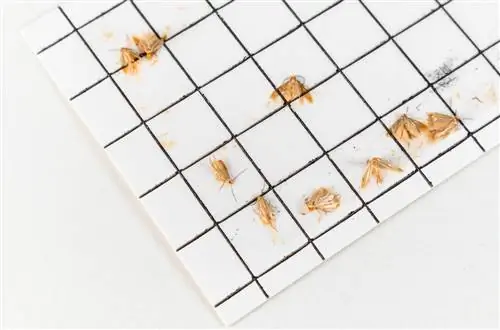
Pheromone traps are very effective in the fight against meal moths
Flour moths are nocturnal and masters of camouflage. It is therefore problematic to be able to estimate the success of a control measure. The pheromone trap exists for this purpose. This is an adhesive trap with a special sexual attractant for male meal moths. The trap tricks males willing to mate into believing that females are present. The attracted butterflies stick to the board. Based on the number, you can estimate the infestation pressure and decide on how to proceed. Furthermore, pheromone traps decimate the number of male food moths and optimize the control success.
Ready-to-use pheromone traps against food moths are available in drugstores, pharmacies, garden centers, hardware stores and online shops. The sticky traps are odorless, have no toxins in their luggage and fulfill their role as a control instrument and moth trap for around 3 months.
Where is there a threat of flour moth infestation
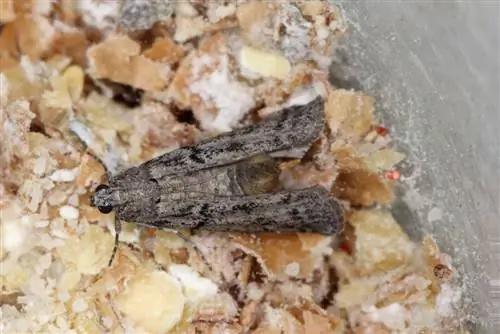
Flour moths love dry foods such as grains, muesli, sauce thickeners etc.
Flour moths are not picky when it comes to finding potential egg-laying locations. In fact, the name disguises the fact that the pests can contaminate far more food than flour. The following list summarizes where the voracious moth maggots can settle:
| Sprinkly foods | dried foods | other locations |
|---|---|---|
| Flour | cereal flakes | Dry dog food |
| Sauce binder | Tea, coffee, cocoa | Dry cat food |
| Gries | Dried fruit | Bird food |
| Sugar, s alt | Dry peas | Cat Litter |
| Chocolate sprinkles | Cornflakes, muesli | |
| Spices | Herbs |
Preventing flour moths - tips & tricks
Meal moths hate peppermint oil. If female butterflies smell essential oils of all kinds in the kitchen or pantry, they turn away in disgust and run away. We have put together these and other preventive measures for you below:
- Lay out lavender in bags in the kitchen
- Spread bay leaves in drawers and stick them on the inside of storage containers
- Check food packaging for holes before buying and if necessary, do not buy
- Store freshly purchased food in airtight containers made of glass, metal or plastic
- Fit windows and balcony doors with fly screens
- Set up pheromone traps as an early warning system and replace them every 3 months
Check the kitchen and pantry rooms at least once a month for tell-tale webs and threads in dark corners. Do not leave food open for long periods of time. Clear away your dog's or cat's dry food bowl as soon as possible. Meticulous cleanliness is a proven prevention against food moths and numerous other pests in the house.
Frequently asked questions
Are flour moths harmful to he alth?
This question can be answered with a clear yes. Moths and larvae leave behind various residues in dry food, such as threads, feces and webs. Pathogenic pathogens such as fungi, mites or bacteria settle on them. Accidental or intentional consumption of contaminated food can cause significant discomfort. Most people affected are people with previous illnesses and small children.
Can you eat flour moth maggots?
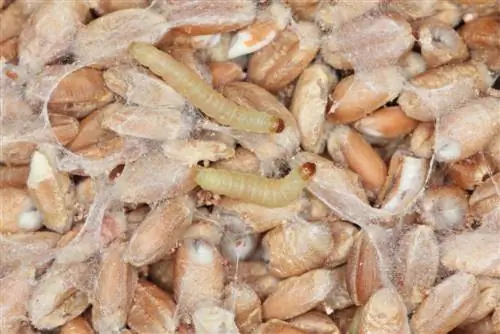
Flour moth maggots are basically edible
Survival training experts recommend maggots of all kinds as rich food in times of emergency. In fact, you can eat flour moth maggots. Of course, you should ignore the foods in which the larvae live. Although the eggs, maggots and moths are not poisonous, they contaminate dry food with feces and sticky threads. Therefore, pick individual worms from flour, grain or muesli, taste the living food and throw away the contaminated food.
How does the control of meal moths with parasitic wasps work?
Parasitic wasps are tiny insects, barely larger than the dot of an i. In order to reproduce, the small creatures depend on a host. For the species Trichogramma evanescens, these are the eggs of flour moths. Female parasitic wasps lay their own eggs there with their ovipositor stingers. The parasitic wasp larva feeds on the host's egg, preventing the moths from reproducing further. Hatched parasitic wasps parasitize additional moth eggs. If there are no more eggs left, the beneficial insects migrate or crumble into dust. You can order parasitic wasps in the pupal stage and distribute them in the kitchen.
How do I recognize a flour moth infestation in good time?
When buying food, look out for holes in the packaging. Meal moths can bite through more than just paper and cardboard. Plastic and other synthetic materials also do not pose an obstacle. Packaging with dry contents such as flour, rice, nuts, cornflakes, dried fruit, tea or herbs is particularly affected. Regularly check food packaging on the pantry shelf for suspicious holes. It's better to put food in airtight glass containers immediately after buying it.
How can I fight meal moths without poison?
The first step is to sort out all the foods you suspect. Also include food supplies in the immediate vicinity. Do not immediately throw food that has a flour moth infestation into the trash can. Instead, freeze the contaminated supplies for two days or put them in the oven at 60 to 80 degrees for two hours. Thoroughly clean the locations with vinegar. Additionally, heat the corners with a hairdryer or sprinkle diatomaceous earth. You can control the success of the fight with pheromone traps.
Fighting meal moths with purchased parasitic wasps is quite expensive. How can I attract the beneficial insects?
Parasitic wasps have a fine nose and are primarily guided by scents. The menu includes nectar, honeydew and flower pollen. A natural garden with varied planting magically attracts the delicate beneficial insects. Umbelliferous plants in particular are very popular with parasitic wasps because they like to snack on the nectar. By growing dill, parsley, maggi herb, angelica and other umbelliferous plants on the windowsill in pots and flower boxes, there is a good chance that parasitic wasps will get into living spaces. However, it is doubtful whether the number is sufficient to successfully combat flour moths.
Tip
Are flour moths still sticking to a pheromone trap even though you have consistently used all control strategies? Then dry arrangements and even dried flowers come into focus. If the female butterflies are denied other places to lay eggs, the clever insects quickly set up the nursery in dried flowers.

